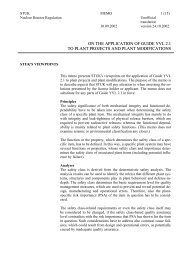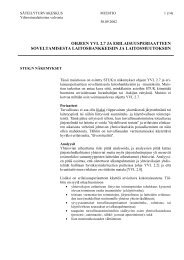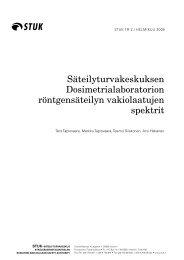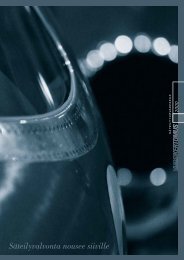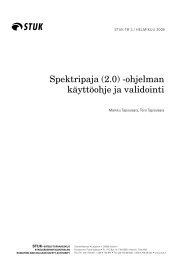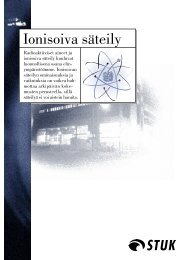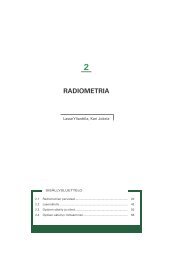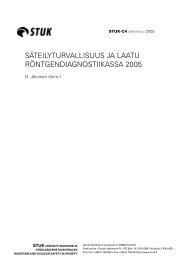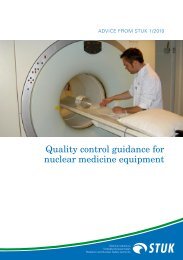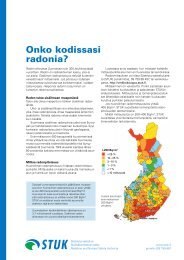Whole report - STUK
Whole report - STUK
Whole report - STUK
You also want an ePaper? Increase the reach of your titles
YUMPU automatically turns print PDFs into web optimized ePapers that Google loves.
<strong>STUK</strong>-YTO-TR 175<br />
9 CONCLUSION<br />
In the measurements performed in September and<br />
December 1999 using the upgraded fork detector,<br />
the calculated correlations of the measurement results<br />
are improved as compared to the corresponding<br />
correlations of the data measured in November<br />
1998. Several reasons can be attributed to this<br />
improvement. First the data quality is improved,<br />
because<br />
• the upgraded fork measures all signals on the<br />
same vertical level;<br />
• the data on one vertical level was taken on all<br />
four sides of the assembly and these results<br />
were averaged;<br />
• neutron data measured in November 1998 have<br />
been corrected only for cooling time whereas<br />
for the 1999 data both the 244 Cm share and the<br />
initial enrichment correction were applied.<br />
As the measure of the burnup, three different signals<br />
were tested:<br />
• spectrometrically measured 137 Cs peak intensity,<br />
• raw gross gamma signal from a pair of ionisation<br />
chambers and<br />
• gross gamma signal with subtraction of the<br />
contribution of 134 Cs and 106 Ru/Rh based on the<br />
spectrometric data.<br />
The measurement results were reduced to the fuel<br />
discharge date and compared with the calculated<br />
values obtained by the PYVO code.<br />
The 134 Cs and 106 Ru/Rh corrections on the gross<br />
gamma seem to be successful. The reason to this<br />
is probably that the gross gamma data are less<br />
sensitive to the positioning error than the measured<br />
137 Cs activity data. The gross gamma signal<br />
with these corrections applied seems to be a good<br />
candidate for the measure of the burnup in neutron-to-burnup<br />
correlation. One calibration curve<br />
can be used for three different BWR assembly<br />
types of similar design. These hypotheses need<br />
additional experimental verification, before they<br />
can be generally adopted. Separate burnup verification<br />
can be performed using the gross gamma<br />
vs. burnup reference curve.<br />
When the spent fuel assemblies are disposed of<br />
into the final repository they will obviously have<br />
such long cooling times that the gamma spectrometric<br />
corrections in gross gamma signal would<br />
not be needed. The gross gamma signal would<br />
consist predominantly of the gamma emission of<br />
137<br />
Cs while other isotopes have decayed off. However,<br />
the gamma spectroscopic measurements are<br />
important to verify that the gross gamma signal<br />
does not include abnormal isotopes originating<br />
e.g. from irradiated dummy rods.<br />
The measurement time was 100 s in these<br />
measurements. It is adequate for making the<br />
gamma spectrometric corrections to the gross<br />
gamma signal. If the Cs-ratio ( 134 Cs/ 137 Cs) were<br />
used as a measure of burnup, a considerably<br />
longer measurement time would be required. It<br />
would increase the costs and reduce the smoothness<br />
of the measurements. In addition, it is not an<br />
option when the spent fuel assemblies with long<br />
cooling time are disposed of into the final repository,<br />
because the 134 Cs has already decayed off.<br />
Also in these measurements many assemblies<br />
were so old that the Cs -ratio could not be used as<br />
a measure of burnup.<br />
In the analysis of the data the correction for<br />
the share of 244 Cm neutrons in the measured<br />
neutron count rate was taken into account based<br />
on the results obtained from calculations with<br />
PYVO. In addition, the calculated 244 Cm neutron<br />
source and the 137 Cs activity of the measured<br />
assemblies were obtained with help of the PYVO<br />
code. All in all, PYVO can be considered as an<br />
essential tool in the analysis of neutron and gamma<br />
data for partial defect verification purpose.<br />
Because the measured assemblies have differ-<br />
34



